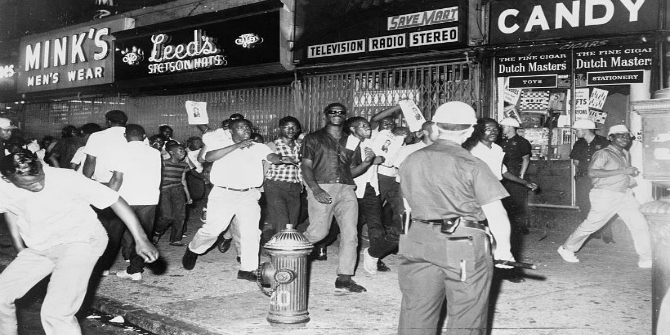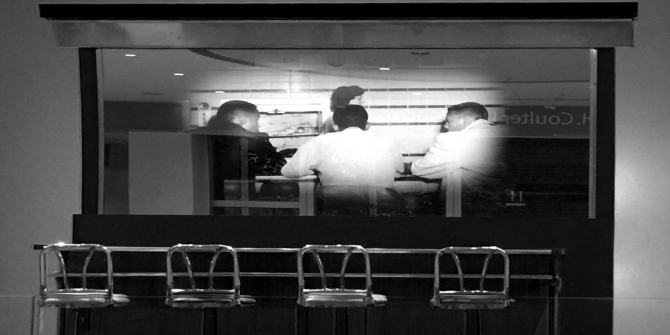In The Sit-Ins: Protest and Legal Change in the Civil Rights Era, Christopher W. Schmidt offers a new account of the crucial civil rights protest inspired by the first ‘sit-in’ by four college students in Greensboro, North Carolina, in 1960. Focusing on the legal issues and constitutional challenges posed by the sit-in movement, the book is a valuable and accessible tool for students and teachers of US and African American history and a reminder of the power of such gestures towards freedom, writes Eraldo S. Santos.
The Sit-Ins: Protest and Legal Change in the Civil Rights Era. Christopher W. Schmidt. University of Chicago Press. 2018.
1 February 1960. ‘I’m sorry, we don’t serve colored in here,’ explained the waitress, as Ezell Blair Jr., Franklin McCain, Joseph McNeil and David Richmond, first-year students at North Carolina Agricultural and Technical College, entered the Woolworth store in Greensboro and sat down at the lunch counter. By the end of business hours, they had still not been served. They remained seated until the lunch counter closed and came back, with more contingents, the following day.
The students’ bold gesture of protest in the face of the persistence of racial segregation in the US South could have been, as similar cases in the past, an isolated one. Such ‘sit-ins’, as their form of protest would become known, quickly spread to other localities, however. By the end of the month, high school, college and university students had followed the Greensboro student’s playbook in thirty cities across seven Southern states. The Sit-Ins: Protest and Legal Change in the Civil Rights Era retells the story of this crucial moment of American history, focusing on a mostly neglected aspect of the sit-in movement: the legal issues and constitutional challenges represented by the students’ protest.
A specialist in constitutional law and a legal historian, Christopher W. Schmidt has a record of insightful, transdisciplinary research that illuminates the role of law and legal change in the US political imaginary. By taking seriously the ways in which different social actors interpret constitutional law outside the courts and law schools, Schmidt inscribes The Sit-Ins in a tradition of legal scholarship which seeks to draw our attention to the historical development of US ‘popular constitutionalism’: ‘the rich blend of legal norms, moral sensibilities, and public policy with which the American people contest, and sometimes remake, the meaning of the Constitution’ (66).
 Image Credit: Greensboro (NC) Lunch Counter, The National Museum of African American History and Culture, Washington, DC (Ron Cogswell CC BY 2.0)
Image Credit: Greensboro (NC) Lunch Counter, The National Museum of African American History and Culture, Washington, DC (Ron Cogswell CC BY 2.0)
The book’s architectonic is faithful to this background enterprise, respectively dedicating each of its six chapters to the ways the students, the civil rights lawyers, the sympathisers of the sit-in movement, its opponents, the Supreme Court Justices and the lawmakers ‘assessed the costs and benefits of relying on legal institutions’ (12). By covering the period between the genesis and development of the sit-in protests in 1960 and the passing of the Civil Rights Act in 1964, Schmidt shows how a minor issue in the civil rights agenda developed into a top priority for the movement, and how nonviolent direct action became an increasingly valued political tactic vis-à-vis lobbying and court litigation.
Although students mostly resisted efforts to translate their moral, political revindications in legal terms, at the core of the controversy ignited by their protest was the question of whether public accommodations owners were required to offer racially non-discriminatory services in their businesses. After its landmark decision in Brown v. Board of Education (1954), which declared school segregation unconstitutional, the Supreme Court extended the requirement of desegregation to other public-operated facilities, such as beaches and golf courses (1955), buses (1956) and public parks (1958), i.e. ‘areas of public life that fell under direct state control’ (85). From a constitutional point of view, nevertheless, private-owned facilities open to the public, such as lunch counters, were a different matter.
Store owners could be said to have, so contended many ideologues of segregation and libertarians alike, a ‘right to discriminate’, which could be traced to a variety of constitutional rights: the ‘freedom of choice’ and ‘property rights’ ensured by the due process clauses of the Fifth and Fourteenth Amendments, the ‘right to associate’ protected by the First Amendment and, more perversely, as the Thirteenth Amendment was originally conceived to abolish slavery, the ‘right against involuntary servitude’ (109). Moreover, as many opponents of the sit-in movement argued, trespass and disturbing-the-peace laws were race-neutral. Enforcing them would be fundamental in protecting social order.
The main legal argument formulated in defence of the protesters and in favour of the desegregation of public accommodations concerned the equal protection and state action doctrines. None of the States of the federation, so provides the Constitution’s Fourteenth Amendment, shall ‘deny to any person within its jurisdiction the equal protection of the laws’. In its unanimous decision in Shelley v. Kraemer (1948), the Supreme Court had declared, drawing on this equal protection clause, that judicial enforcement of racially-based restrictive covenants was unconstitutional. Accordingly, the state could not protect private discrimination through the arrest or prosecution of the sit-in protesters.
By articulating aspirational constitutional claims – that is, claims ‘without solid footing as a matter of court-defined constitutional law’ (66) – sympathisers and opponents of the movement pressed ‘formal legal actors’ to offer a response to the issue. Since by 1964 the Supreme Court had repeatedly avoided the central constitutional question by striking down the protesters’ convictions on narrow grounds, extrajudicial debates on the matter proved to be crucial for the students’ cause. This time, the main transformation would come from outside the courts: a shift in the nation’s consciousness which would generate ‘an emerging public consensus, eventually captured and enforced through an act of Congress’ (68).
After months of debate and filibuster, Congress passed, and President Johnson signed into law, the Civil Rights Act, whose Title II outlawed racial discrimination in public accommodations, primarily under the commerce clause of the Constitution, which regulates interstate commerce rather than the equal protection clause of the Fourteenth Amendment. In the end, the Supreme Court would leave unresolved the original conundrum concerning the limits of state action and thereby the boundaries between the public and private spheres.
Without a doubt, one of the book’s strongest merits is to make US constitutional law and doctrine accessible to the interested layperson. It will serve as a valuable tool for students and teachers of American and African American history, political theory and philosophy as well (Hannah Arendt scholars will certainly find a special interest in this read).
Its political message should not, nonetheless, be underestimated. Schmidt’s book compellingly shows how ‘public expectations about the Constitution can be shaped not only by signals from authoritative constitutional interpreters, such as courts, but also by transformative acts of social protest’ (13). And he urges us to take the sit-ins movement’s lessons seriously, by finding new ways to ‘combine social protest and legal claims to disrupt those practices and policies that perpetuate old inequalities and create new ones’ (183). It is a pity, in this regard, that the book’s Conclusion does not further develop the specific legacies of the public accommodations debate in contemporary constitutional doctrine and the heritage of the ‘right to discriminate’ argument in US public discourse. It would surely interest not only those at the battlefronts of the African American freedom struggle, but also activists in other trenches, such as LGBT+ movements.
At times, it seems that ‘hamburgers are more important than human rights,’ as Justice Goldberg famously lamented. Freedom is, however, certainly ‘something much bigger than a hamburger or even a giant-sized Coke’, as activist Ella Baker once put it. By showing that no gesture towards freedom – not even a ‘lonely, defiant act of protest’ (180) – is relegated by history to remain a small one, Schmidt’s book proves to be a helpful resource for those seeking inspiration in the past.
- This review originally appeared at the LSE Review of Books.
Please read our comments policy before commenting.
Note: This article gives the views of the authors, and not the position of USAPP– American Politics and Policy, nor of the London School of Economics.
Shortened URL for this post: http://bit.ly/2M5NX05
About the reviewer
Eraldo S. Santos – Paris I – Panthéon-Sorbonne
Eraldo S. Santos is a PhD candidate at University of Paris I – Panthéon-Sorbonne. His doctoral research focuses on the history of the concept of ‘civil disobedience’. He analyses how it was reformulated in the context of the revival of political obligation theories in the US during the 1960s and 1970s. The project is funded by the Coordination for the Improvement of Higher Education Personnel (CAPES, Brazil). Read more by Eraldo S. Santos.


 Find this book:
Find this book: 

